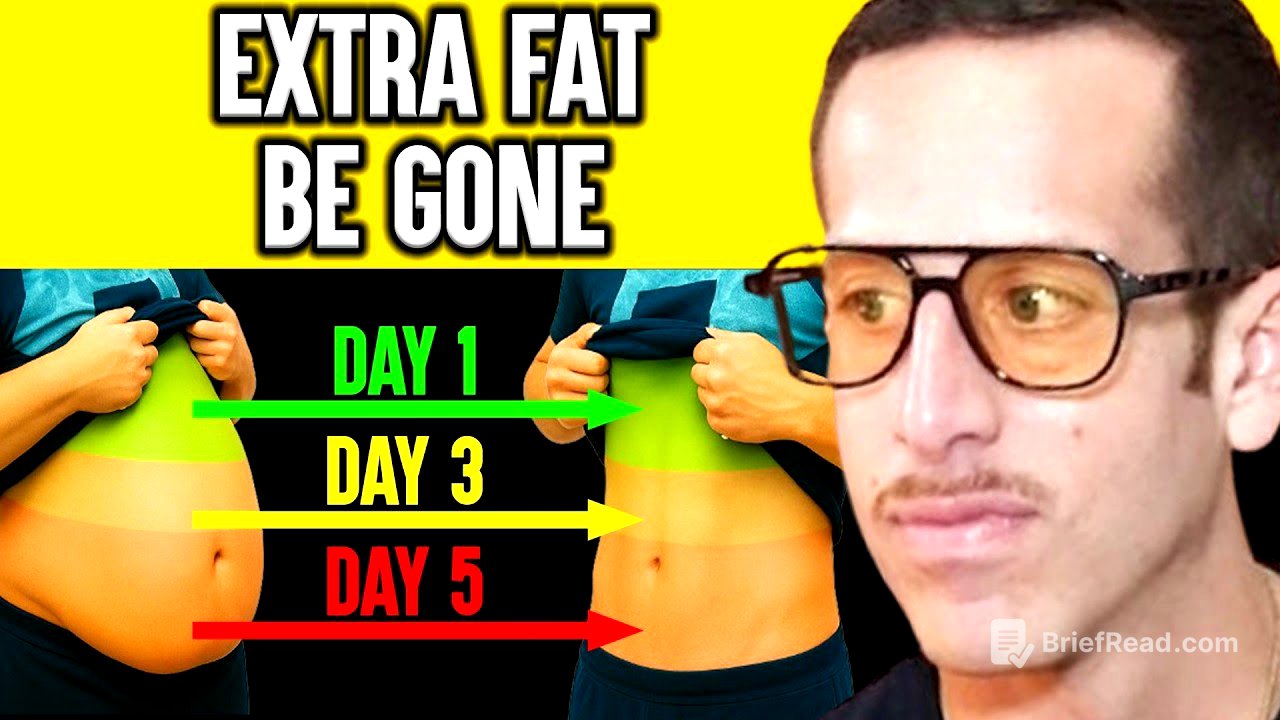TLDR;
This video presents a 5-day protocol designed to help you lose 5-10 pounds of stubborn belly fat by reducing inflammation and waking up your metabolism. It focuses on lowering cell inflammation, optimising meal timing, incorporating post-meal walks, using apple cider vinegar, and prioritising protein intake.
- Lower cell inflammation by avoiding certain foods.
- Implement specific meal timing strategies.
- Incorporate post-meal walks.
- Consume apple cider vinegar before meals.
- Prioritise protein intake.
Lower Cell Inflammation [0:39]
The first step involves reducing cell inflammation by eliminating five key inflammatory foods from your diet. These foods hinder fat-burning hormones and overall cellular communication. The first food to avoid is high fructose corn syrup, found in many processed foods like condiments, as it overwhelms the liver, leading to fatty liver and increased inflammation. Secondly, eliminate seed oils (canola, corn, cottonseed, sunflower, safflower, soybean, rice bran, and grapeseed oil), which are prevalent in packaged foods and restaurants, and replace them with healthier saturated and monounsaturated fats like butter, ghee, beef tallow, duck fat, coconut oil, avocado oil, and olive oil. Thirdly, avoid processed carbohydrates such as white bread, pastries, and anything with a long ingredient list, opting instead for single-ingredient foods. Fourthly, eliminate fruit juice and smoothies due to their high fructose content, which overloads the liver. Finally, reduce overall carbohydrate intake, even from whole food sources like sweet potatoes and rice, to keep insulin levels low and promote fat burning. Aim for under 100 grams of total carbs by day five, or ideally under 50 grams.
Optimise Meal Timing [6:18]
Step two focuses on meal timing: avoid eating at least 3 hours before bed and eliminate snacking between meals. Eating too close to bedtime disrupts sleep, which is crucial for fat burning, detoxification, and healing. Poor sleep promotes fat storage, inflammation, and increased hunger. Allow energy to be used for healing during sleep, not digestion. Close the kitchen at least 3 hours before bed, or ideally 5 hours. A helpful tip is to brush your teeth after your last meal to discourage late-night eating. Additionally, eliminate snacks between meals to prevent spikes in glucose and insulin, which promote fat storage. Stick to breakfast, lunch, and dinner without any in-between snacks.
Incorporate Post-Meal Walks [8:25]
The third step involves taking a 10-30 minute walk after each meal. While a 30-minute walk after every meal is optimal, even 10 minutes can be beneficial. Prioritise walking after your largest meal. Walking after eating helps blunt glucose spikes, reducing the amount of insulin produced and promoting a faster transition to a fat-burning state. This practice also improves digestion. You can walk outside, use a walking treadmill, or simply walk around your house.
Consume Apple Cider Vinegar [9:53]
Step four recommends consuming 2 tablespoons of apple cider vinegar with water 30 minutes before each meal, or at least before your largest meal. Apple cider vinegar slows gastric emptying and reduces post-meal blood sugar spikes, leading to less insulin production and quicker fat burning. It also enhances insulin sensitivity and boosts satiety. The acetic acid in apple cider vinegar is key for insulin sensitivity. Mix 2 tablespoons of apple cider vinegar with 8 ounces of spring water and drink through a straw to protect your teeth. Alternatively, consider apple cider vinegar capsules. This practice can reduce bloating, digestive issues, and acid reflux, while increasing fat loss and energy levels.
Prioritise Protein Intake [11:18]
The fifth step emphasises consuming at least 40 grams of protein at each meal. Protein is the ultimate fat loss macronutrient, boosting muscle protein synthesis, which increases your metabolic rate and fat burning. Increased muscle mass improves insulin sensitivity, allowing muscle cells to absorb glucose more effectively and reducing insulin production. Protein also reduces the hunger hormone ghrelin and activates chemicals that promote feelings of fullness and satiety, preventing overeating and snacking. Additionally, protein activates the thermic effect of food, increasing your resting metabolic rate. Examples of 40 grams of protein include 6 ounces of grass-fed beef, seven eggs, two scoops of clean protein powder, or a wild-caught salmon fillet.









